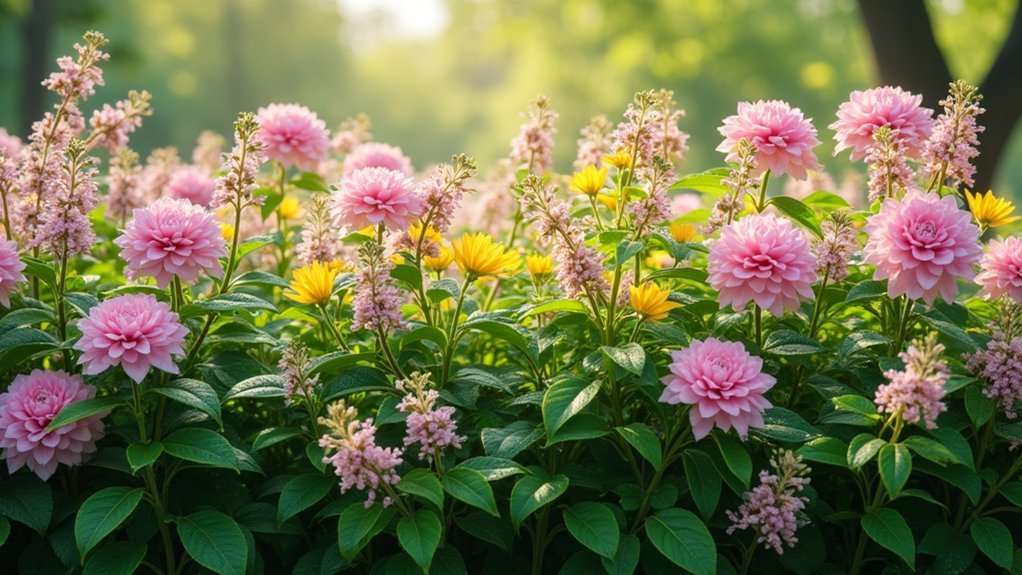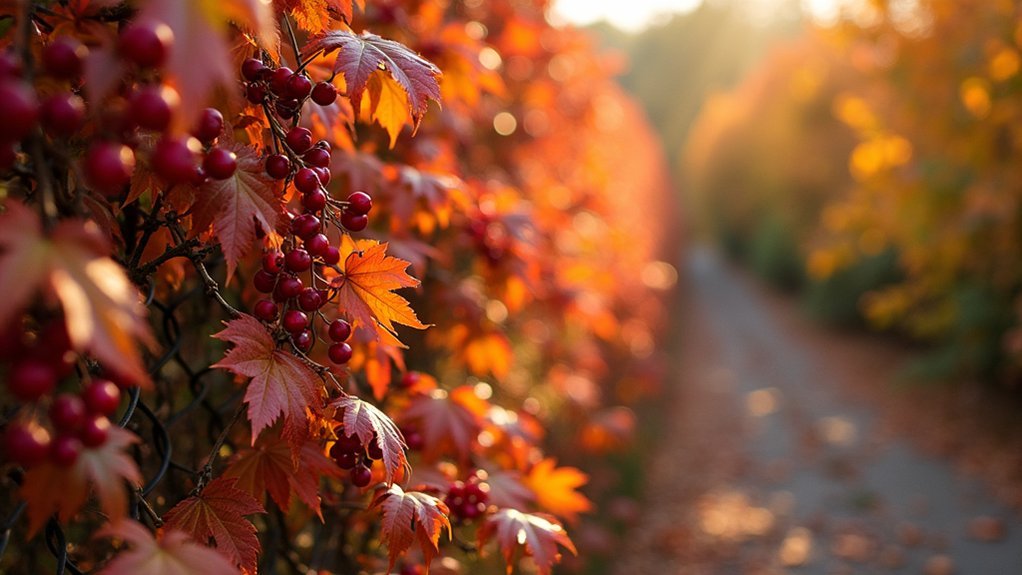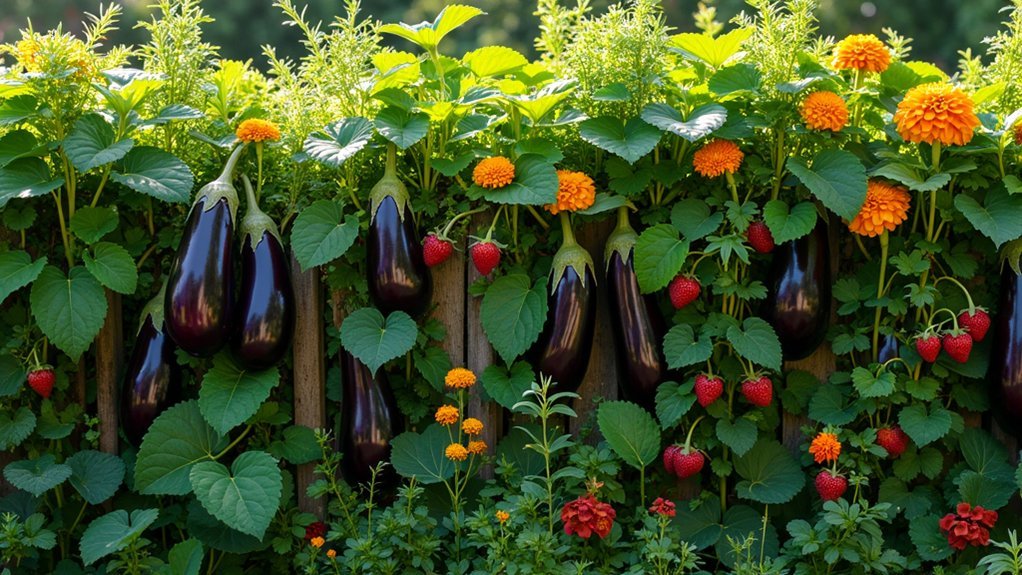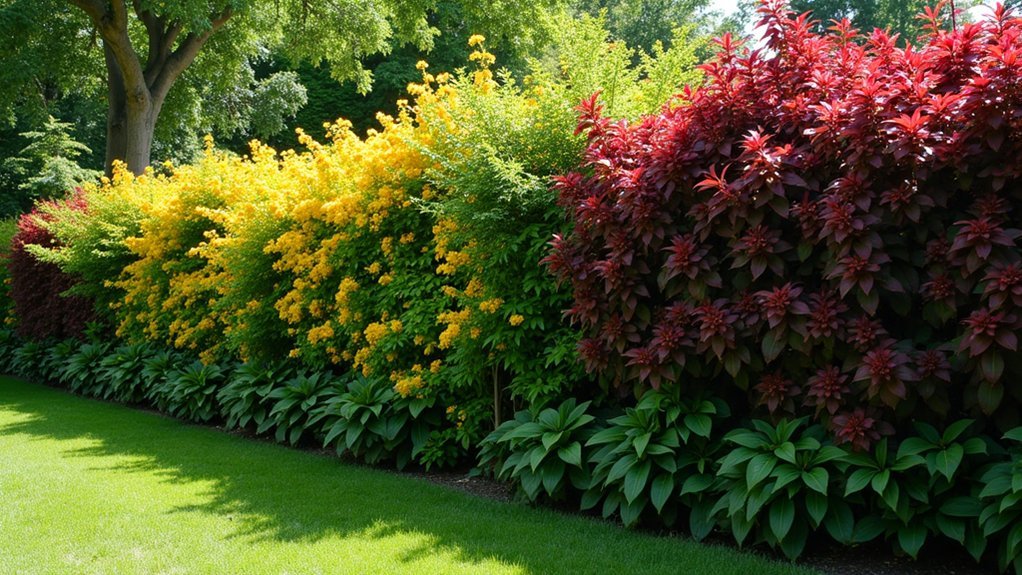Transform your living fence into a vibrant, year-round display by strategically selecting plants for seasonal interest. Incorporate spring flowering species like grape hyacinths, summer textural elements with variegated foliage, autumn’s fiery palette of berry-producing viburnums, and winter structural elements from evergreens. Layer plants of varying heights and textures for dimension, and consider adding edible varieties for both beauty and function. Your fence can become more than just a boundary—it can be a living canvas of natural color.
Spring Awakening: Flowering Species for Vibrant Borders

When does your garden truly come alive? For many, it’s that magical moment when spring’s first blooms push through winter’s remnants, signaling nature’s reawakening.
That first green breakthrough—winter’s end, spring’s promise, the garden awakening once more.
Start your border’s evolution with early risers like snowdrops, which often emerge while frost still lingers. Pair them with grape hyacinths, whose vibrant blue clusters create stunning ground-level interest.
For shadier spots, primroses and hellebores offer reliable color from March through April. Consider integrating Weigela shrubs whose tubular flowers attract hummingbirds and create visual interest throughout the growing season.
As spring matures, incorporate Virginia bluebells for naturalized woodland effects or bearded iris for dramatic vertical elements.
Don’t overlook the textural contrast of lamb’s ears, whose silvery foliage complements both early and mid-season bloomers.
For consistent moisture areas, astilbes provide feathery plumes that flow beautifully from spring into summer’s palette.
Summer Canopy: Rich Foliage and Texture Combinations
Summer’s warmth transforms your living fence into a textural paradise where foliage takes center stage. Create stunning visual contrasts by pairing variegated specimens like Jazz Hands Loropetalum with deeper green plants, or golden foliage against dark glossy leaves as seen with Golden Globe Arborvitae alongside Jubilation Gardenia.
Don’t overlook texture—incorporate woven willow branches for eco-friendly privacy or mix thorny holly with smooth-leaved varieties for depth. Privet hedges create dense living fences that effectively block views while maintaining an attractive appearance.
English Ivy climbing a lattice fence delivers a lush, dense canopy that completely transforms rigid structures.
For sustainable options, consider fast-growing bamboo which requires minimal maintenance while providing vibrant greenery.
Autumn’s Fiery Palette: Berry and Leaf Color Transitions

As autumn approaches, your living fence transforms into a spectacular display of nature’s artistry with fiery hues and ornamental berries.
Compact American cranberry bush delivers a stunning performance as glossy green foliage shifts to purple-red while bright red berries persist, attracting birds throughout the season.
For maximum impact, pair red-berried viburnums with shrubs that develop contrasting yellow-red foliage.
Position these showstoppers where autumn light can illuminate their chromatic brilliance against a warm-toned fence.
Arrowwood viburnum offers the bonus of supporting pollinators and butterfly larvae while developing rich fall color.
Consider staggering varieties with different berry ripening times to extend seasonal interest and provide continuous wildlife support.
This ecological approach reduces maintenance demands while creating a living privacy screen that celebrates autumn’s fleeting beauty.
Living fences provide noise dampening benefits while adding visual interest to your outdoor boundary.
Winter Interest: Structural Elements and Evergreen Backbones
Your living fence doesn’t have to hibernate during winter when you incorporate structural elements that stand proud against the snow.
Evergreen backbones like pyramidal arborvitae and columnar junipers create essential visual anchors, while plants with distinctive bark textures—such as exfoliating river birch or red-twig dogwood—add dramatic contrast. Consider adding a strategically placed bench to create a focal point in your winter landscape.
The rich palette of evergreen varieties, from gold-tipped ‘Rheingold’ to blue-hued ‘Wichita Blue’ juniper, guarantees your boundary remains vibrant even in the coldest months.
Winter Interest: Structural Elements and Evergreen Backbones
When winter strips away autumn’s colorful foliage, the true bones of your garden emerge, revealing the importance of thoughtful structural elements. Your living fence becomes a critical anchor during these sparse months.
Incorporate evergreen conifers like Blue Spruce or Dwarf Alberta Spruce to maintain form and color year-round. Their pyramidal shapes create striking silhouettes against snow.
Layer with low-growing juniper or boxwood to reduce bare soil exposure while adding textural variety.
Don’t overlook architectural elements – wooden lattices, stone walls, or strategically placed benches serve as visual anchors. Consider incorporating compelling shapes through strategic pruning of your evergreens to create unique forms that stand out in the winter landscape.
Plants with distinctive bare-branch patterns, such as contorted hazel, create dramatic shadows and silhouettes.
Bark Texture Showcase
Textural riches emerge during winter’s stark simplicity, transforming your living fence into a tactile gallery of natural art.
You’ll discover a spectrum from smooth, sleek surfaces to deeply fissured patterns that add dimensional depth to your garden boundaries.
Incorporate trees with distinctive bark characteristics—the reddish-brown Fire Cherry or rustic cork bark with its high natural variation.
These textures cast dramatic shadows in winter light, creating ever-changing visual interest against snow or frost.
When preserved as panels, authentic bark textures provide acoustic dampening and insulation benefits while maintaining their rustic character.
Your fence’s bark elements can showcase natural color variations from deep earth tones to splashes of crimson and rusty orange. Consider installing poplar bark sections, which deliver unique appeal due to no two panels being identical in their natural imperfections.
These hues complement evergreen backbones and maintain visual impact when leaves have fallen, ensuring your living fence remains a focal point year-round.
Evergreen Color Varieties
The backbone of any winter garden, evergreens infuse your living fence with rich chromatic diversity long after deciduous plants have shed their leaves.
You’ll find endless possibilities beyond basic green, from the silvery gray-green of junipers to the striking blue-green of spruce and cedar varieties.
Consider incorporating these enchanting evergreen elements:
- Contrasting textures – Pair feathery false cypress with glossy-leaved holly for dramatic visual interest
- Year-round color stories – Mix gold-tinted juniper varieties with dark green boxwood for a sophisticated palette
- Winter berries – Plant holly bushes that display vibrant red fruits against deep green foliage
- Structural diversity – Combine conical arborvitae as anchors with spreading wintercreeper as ground cover
Your living fence doesn’t have to hibernate – evergreens guarantee your landscape remains a visual feast throughout winter. For vertical emphasis in narrow spaces, consider Sky Box Japanese Holly with its shiny dark foliage and columnar habit that creates an elegant natural screen.
Succession Planting for Year-Round Visual Impact
Orchestrate a year-round display by planning your living fence with plants that bloom or offer visual interest in different seasons.
You’ll need a strategic calendar that maps out when to introduce early spring bloomers, summer showstoppers, and fall foliage favorites to prevent gaps in your fence’s appeal.
Consider including native thorny shrubs like hawthorne that provide both security and seasonal visual interest to your living fence design.
Seasonal Bloom Orchestration
Creating visual impact throughout the year requires thoughtful succession planting, where each season offers fresh interest to your living fence. By combining early-flowering vines like Passiflora incarnata with mid-season shrubs and late-blooming beautyberries, you’ll craft a living tapestry that evolves with the calendar.
- Spring Awakening – Incorporate wisteria’s dramatic purple cascades to create a breathtaking first impression that signals renewal.
- Summer Abundance – Layer variegated foliage plants for texture when spring blooms fade, maintaining visual richness. Ornamental kiwi (Actinidia kolomikta) adds unique dimension with its pink and white foliage.
- Autumn Transformation – Include shrubs that develop vibrant berries or foliage as temperatures drop, extending your color story.
- Winter Structure – Balance deciduous and evergreen species to guarantee your fence maintains architectural interest even in dormant months.
Sequential Planting Calendar
Everyone needs a structured timeline to transform a living fence from a static boundary into a dynamic, ever-evolving display. Start by dividing your fence line into thirds or quarters, allowing for staggered planting every 2-3 weeks.
Map out your year with climate-adapted scheduling—begin cool-weather successions 4-6 weeks before last frost, then shift to heat-resistant varieties like ‘Jericho’ lettuce during summer months. Exploit microclimates by using south-facing sections for extended growing windows.
Maintain biweekly audits of soil moisture and conduct pre-germination prep 7-10 days before outdoor planting dates. Pair fast-growing elements (20-30 days) with slower-developing ornamentals for textural contrast. Incorporating a diverse range of vegetable varieties helps reduce pest pressure while creating visual interest in your living fence.
As seasons change, incorporate evergreen anchors for winter structure, spring bulbs for early color, and warm-toned blooms for summer intensity.
Native Plant Selection for Regional Color Authenticity

When you incorporate native plants into your living fence, you’re not just creating a boundary—you’re establishing an authentic extension of your region’s natural landscape. Native dogwoods, mixed hedges of evergreen and deciduous shrubs, and ornamental grasses all contribute to a color palette that truly belongs in your environment.
- Connect with your roots by selecting plants that have thrived in your region for centuries, creating a sense of place and belonging.
- Celebrate the seasons through plants that transform throughout the year, offering an ever-changing canvas.
- Support local wildlife with familiar food sources and shelters that make your property come alive with movement. Native shrubs like viburnums and willows serve as valuable host plants for numerous butterfly and moth species while providing essential cover for birds.
- Create resilience by choosing plants already adapted to your climate, requiring less maintenance while standing strong against local challenges.
Layering Techniques for Multi-Seasonal Color Depth
Your living fence can showcase spectacular color throughout the year by combining plants with staggered blooming periods.
Select a mix of early spring bulbs, summer-flowering shrubs, and autumn foliage plants to guarantee continuous visual interest as each season shifts to the next.
You’ll create depth and dimension when you arrange taller woody specimens at the back and shorter herbaceous plants toward the front, allowing each layer to shine during its peak performance time. Incorporating textural variations among your plant selections adds visual contrast to your living fence while enhancing its overall aesthetic appeal.
Multi-Season Plant Selection
Creating a truly enchanting living fence requires strategic layering techniques that provide visual interest throughout the year.
By selecting diverse plants that shine in different seasons, you’ll transform your boundary from a mere divider into a dynamic, ever-changing tapestry of colors and textures.
- Spring to Summer Shift – Mix early-blooming perennials with summer annuals for continuous color that evolves from delicate spring pastels to bold summer hues. Consider implementing companion planting combinations that enhance both beauty and the overall health of your living fence ecosystem.
- Summer to Fall Drama – Incorporate plants with vibrant autumn foliage that create a fiery display as temperatures drop.
- Winter Wonder – Add evergreens and plants with striking berries or bark to maintain structure and interest during dormant months.
- Year-Round Foundation – Guarantee at least 30% of your selections provide constant presence through evergreen foliage or architectural form.
Staggered Blooming Strategy
Beyond plant selection, mastering the art of layering transforms an ordinary living fence into a spectacular display that captivates year-round. Your fence can become a living calendar of color with thoughtful staggering of bloom times.
Arrange plants so their flowering periods overlap and complement each other. Place spring bloomers like forsythia alongside summer-flowering hydrangeas and fall-showing asters.
Don’t forget winter interest—include plants with colorful berries or interesting bark for those dormant months.
When planting, consider both horizontal and vertical layering. Taller specimens should be positioned behind shorter varieties, creating a gradated effect that draws the eye. These strategic designs offer annual maintenance costs that are 60-80% less than traditional wooden fencing once established.
Combine different foliage textures and shapes for added dimension even when flowers aren’t present. This multi-layered approach guarantees your living fence remains visually striking through every season.
Edible Landscaping: Combining Beauty With Productivity

While traditional fences merely define boundaries, edible landscaping transforms your living fence into a productive paradise that delights both the eye and the palate.
By integrating fruit trees, berry bushes, and climbing vegetables, you’ll create a multifunctional border that serves as both protection and pantry. A thoughtfully planned fence can be visually stunning with careful planning enhancing your home’s overall aesthetic appeal.
- Harvest from Home – Imagine plucking ripe blackberries or crisp apples steps from your door, saving money while enjoying unmatched freshness.
- Living Privacy – Create a lush, edible screen that blocks unwanted views while attracting beneficial pollinators.
- Four-Season Interest – Design your fence with staggered harvests from spring strawberries to fall apples.
- Conversation Starter – Watch neighbors slow their pace to admire your innovative approach to boundary design.
Climate-Specific Color Strategies for Living Boundaries
Your edible living fence offers sustenance, but its colors can also transform your property’s entire aesthetic when matched to your regional climate. By selecting plants that thrive in your specific conditions, you’ll create a boundary that’s both beautiful and resilient.
In tropical areas, incorporate vibrant hibiscus for bold splashes of color. If you’re in a temperate zone, mix deciduous plants like dogwood or maple for seasonal color shifts. Desert dwellers should consider the structural beauty of cacti and succulents, while coastal residents need salt-tolerant options like beach roses.
Don’t overlook microclimates on your property—areas near water, walls, or at different elevations can support unique plant varieties.
Combine evergreens with flowering specimens for year-round interest, and prioritize native species that naturally harmonize with your local ecosystem.
Color Psychology in Natural Barrier Design

The colors you select for your living fence affect more than just its appearance—they influence your psychological well-being and emotional responses to your outdoor space.
Color choices for living fences shape your mental landscape, not just your garden’s visual identity.
Natural color schemes emphasize functionality while creating a serene environment that connects you to nature. Earth tones like brown and beige establish stability, while greens and blues tap into evolutionary preferences that signal safety.
You’ll experience these benefits when incorporating natural colors:
- Stress reduction – Natural greens and blues have been proven to lower cortisol levels.
- Enhanced cognitive function – Immersive natural color environments improve focus and clarity.
- Emotional balance – Earthy tones create psychological stability and groundedness.
- Biophilic connection – Colors with shorter wavelengths (blues/greens) strengthen your innate bond with nature.
Companion Planting for Enhanced Chromatic Effects
Companion planting, once limited to vegetable gardens for practical benefits, now offers living fence designers a powerful tool for creating stunning visual effects.
By thoughtfully combining plants with contrasting flower colors, you’ll create visual interest while attracting beneficial pollinators to your landscape.
Consider pairing vibrant nasturtiums with brassicas for pest control and color, or combine lavender with black-eyed Susans for dramatic contrast.
You can create continuous color by selecting plants with sequential blooming periods, ensuring your living fence remains visually appealing throughout the growing season.
Don’t overlook the importance of varied leaf textures and colors to add depth to your design.
Remember to group plants with similar sunlight, soil, and water requirements together for ideal growth and easier maintenance in your living fence installation.
Pruning and Maintenance for Optimized Color Display
Proper pruning transforms not just the structure of your living fence but dramatically enhances its color display throughout the growing season.
Strategic pruning elevates your living fence from mere boundary to a brilliant, evolving canvas of seasonal color.
Time your cuts for late winter or early spring before new growth emerges, and you’ll stimulate vibrant sprouting. Rather than one heavy pruning session, opt for systematic, regular maintenance to prevent dieback and promote healthier, more colorful regrowth.
- Cut just above buds to channel energy into new, vividly pigmented growth
- Remove competing stems to direct nutrients toward your most colorful branches
- Shape intentional patterns to create stunning visual rhythms of color along your fence line
- Balance branch density to allow light penetration that intensifies leaf and flower pigmentation
Wildlife Attraction Through Strategic Color Planning
Beyond maintaining your living fence’s shape and importance, thoughtful color planning transforms it into a wildlife sanctuary. Choose native plants with vibrant flowers to attract local pollinators and birds familiar with these food sources.
Create a sequence of seasonal blooms by incorporating plants that flower at different times, ensuring year-round resources for beneficial insects. Position butterfly host plants like milkweed alongside nectar-rich varieties such as lavender and coneflower to support complete pollinator lifecycles.
For maximum impact, place your living fence near existing water sources or natural habitats, creating wildlife corridors that connect ecosystems. Use contrasting colors strategically—bright flowers against evergreen backgrounds draw attention from various species.
Mix plants of different heights and shapes to provide diverse habitats, from ground-dwelling insects to nesting birds.
Frequently Asked Questions
How Do Living Fences Affect Property Values?
Living fences can increase your property’s value by enhancing curb appeal, improving privacy, and creating defined outdoor spaces. They signal good maintenance to potential buyers and contribute to neighborhood aesthetics, positively affecting market perception.
Can Living Fences Provide Security Comparable to Traditional Fencing?
Living fences can provide security comparable to traditional fencing if you’re strategic. They offer visual deterrence but have physical limitations. You’ll get maximum protection by combining thorny plants with other security measures.
How Quickly Will My Living Fence Establish Effective Privacy?
You’ll see initial privacy in the first year, but full effectiveness takes 2-5 years depending on plant types, spacing, and care. Fast-growing species like privet establish quicker than slower evergreens or deciduous shrubs.
Are Living Fences Suitable for Small Urban Properties?
Yes, they’re perfect for small urban properties! You’ll maximize limited space with vertical planting, enjoy cleaner air, reduce noise, and create visual appeal. Choose compact varieties and integrate with existing structures for best results.
What Permits Might Be Required Before Installing a Living Fence?
You’ll likely need building permits for structures over 6 feet, zoning permits for setback compliance, and possibly environmental permits in protected areas. Check with your local authorities and HOA for specific requirements in your area.
In Summary
You’ve discovered how to turn your living fence into a dynamic, ever-changing canvas of natural color. By carefully selecting plants for each season, understanding color psychology, and implementing strategic maintenance, you’ll enjoy boundaries that aren’t just functional but visually stunning. Your thoughtfully designed living fence will now provide year-round interest, support local wildlife, and reflect your personal style while seamlessly connecting your property to the surrounding landscape.





Leave a Reply